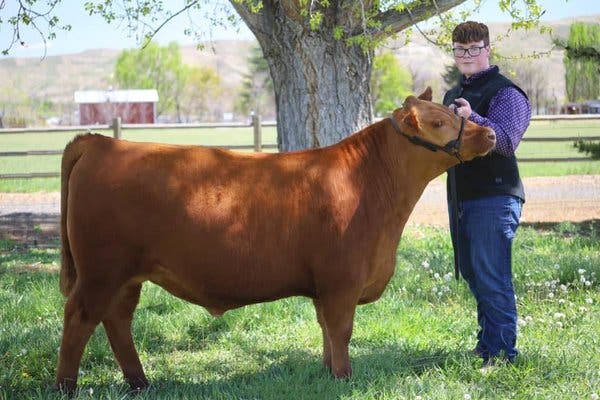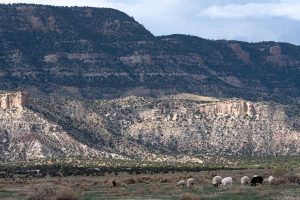The stomach-flipping thrill of riding the Zipper on the midway. The funnel cakes with powdered sugar melting on the fried dough. The shave ice. The sweet, smelly medley of hay, dirt and manure drifting from the barn.
Mia Achziger, 12, loved everything about the Clark County Fair in Washington State. From the minute she left the fairgrounds last year, she had been looking forward to going back. She was eager for judges this summer to view her two goats, Kurt Russell and Sam Elliott, and her 1,000-pound cow, Bell.
But last week officials decided to cancel the fair, adding it to the long list of annual summertime events — held so dear they practically are American traditions — that have been scrapped because of the coronavirus pandemic.
In some areas, fairs have been pared back with the elimination of midway rides and games. Elsewhere, longtime attendees who build their summer schedules around local fairs are waiting to learn whether they will carry on.
Even the presidential candidates are among those waiting for a decision about the Iowa State Fair, which with its giant butter cow, deep-fried Oreos and hordes of voters has become an integral part of the political campaign. Iowa officials said last week they would wait until June to decide whether the fair would open.
For rural children in local 4-H and National FFA Organization clubs, the fair cancellations are a particularly painful blow. They have been tending their animals for months to prepare them for their turns in the ring at livestock shows.
“It’s really frustrating that I will be missing out on all of my showing, and I won’t be able to have fun with all of my friends,” said Mia, a seventh grader who lives in La Center, Wash. “I have made some of my best memories at the fair.”
Leaders of local farm clubs are trying to make up for the losses by hosting online livestock shows, asking children to submit photos and videos of themselves displaying their cows, sheep and goats. The children are filmed walking their animals and pointing out their features, which judges must scrutinize through a computer screen.

“I don’t think anything will ever take the place of a live livestock show — the sights, the sounds,” said Ryan Rash, a popular livestock judge who has been donating time on children’s virtual shows. “But in this time of crisis, it’s all the kids have to look forward to.”
Mr. Rash, an executive director for Texas Junior Livestock Association, is accustomed to running his hands down the side of cows to size up their fat content and to grasping the legs of sheep and goats to check for muscle definition.
Now, he can only scroll back and forth through images to compare animals’ body shapes. It is laborious, he said, and presents new challenges.
“Just like on body builders, you can see muscles pop, but not being able to put your hands on animals — it’s different,” said Mr. Rash, who also co-hosts the podcast “Beyond the Ring.”
Clubs have offered virtual contests for showmanship or on the market potential of their livestock raised to slaughter. Some have added costume and TikTok competitions and contests that require children to show off their barns in the spirit of the MTV show “Cribs.”
In one of the videos, a child introduces her barn with a cartwheel.
In another, Jacob Meads, who belongs to the North Carolina 4-H livestock program, shows off Buckeye, Little Dude and Third Chance — a lamb wearing a coat who has a ball in his pen “so he don’t get bored.”
Virtual livestock shows are not a perfect replacement, but officials say they help reward children for their hard work.
“It’s not just the activity of raising an animal,” said Jennifer Sirangelo, the chief executive of the National 4-H Council. “These shows are critical to developing outcomes for youth. That sense of belonging and recognition is really important.”
County and state fairs are often the crowning moment in a circuit of spring livestock shows, where children are judged on their presentation skills as they walk animals around the ring or display the girth of ones they are hoping to sell.
Brylie Jackson, 9, has worked every afternoon with her crossbred steer, Reveille, to get him to stop hiding in the hay.
“He’s stubborn like me,” said Brylie, a fourth grader from Carlisle, Ohio. “I just tell him to listen and tell him if he does listen, we’ll do good.”

Worried that her cow might catch the coronavirus, she kept him in a stall apart from her family’s herd and fed him away from the other animals.
“I thought if we separated him and if we take good care of him, he’ll be fine,” she said.
She has participated in the Virtual Cattle Battle but is still waiting to hear if the Jackson County Fair will be canceled.
Emma Helsinger, 9, said she was disappointed she did not get to show off her pigs, Luke and Leia, in the ring after training them for months. Luke, in particular, was stubborn at first but she found ways to reward him.
“When he does a good job,” she said, “we would give him a belly rub.”
Emma has entered virtual shows in Ohio, she said, noting that the downside was waiting days for results. In the ring, judges announce awards almost instantly.
Mackenzie Odom, 9, from Columbia, N.C., will not know the outcome for her goat, Mr. Eyelashes, until the end of May. Last year, she won second place for showmanship at the Tyrrell County 4-H Livestock Show.
“I talked to my goat,” she said, explaining her training methods. “I told him to believe in himself.”

Mia, the seventh grader, had entered shows in Washington and Oregon to ensure that by the time the county fair arrived her animals would be accustomed to crowds.
She has known Kurt Russell since he was born. For the past four months, she has watched him zip around the yard until he pants like a dog. She has been careful to exercise him and Sam Elliott daily to develop the wide chest and big rump the judges like to see on Boer goats, a South African breed known for its brown head and white body.
“Some people have old treadmills, and they put their goats on them,” Mia said. “I have not done that. I just tend to walk them around and run with them.”
She believes that her goats would have fetched a good price at the fair but was most looking forward to profiting on her investment in Bell, a hefty Angus cross. She spends hours with the cow every day, washing him, tending his coat with a giant hair dryer and brushing him, careful to comb his hair the opposite direction from which it grows to make him look fluffier. She feeds him apple-flavored horse treats and tolerates him licking her jeans.
“I don’t know why — he just does it,” she said.
Mia was intimidated by Bell’s size at first — he was already 700 pounds when she bought him — but the two have reached an understanding.
“He always seems excited to come up to the gate and play with me,” she said.

Mia first heard about the coronavirus in February, but back then it seemed so far away. No cases had been reported near her hometown. Later that month, her school volleyball tournament was canceled because of the virus, and then so was her first livestock show of the season. The rest were canceled, too.
“I was so sad,” she said.
Mia has found an upside to participating in virtual shows: She can film herself with her animals any time instead of having to rise early in the morning to prepare them. But getting the animals to calm down can be difficult when they are distracted by herdmates mooing or baaing in the distance.
And she has noticed that some of her rivals have found new ways to fudge their entries, adding extra fluff to their cows’ coats to make their bodies appear meatier. Some entrants use cooling rooms to stimulate hair growth — a tactic that judges could easily sniff out in person by touching the cow’s body.
Mia knows she is not likely to profit from the sale of her animals this year, a lesson her mother, Jamie Achziger, said was important.
“This year has taught her the downside of farming,” Ms. Achziger said. “There are bad years where nothing seems to go right.”



















